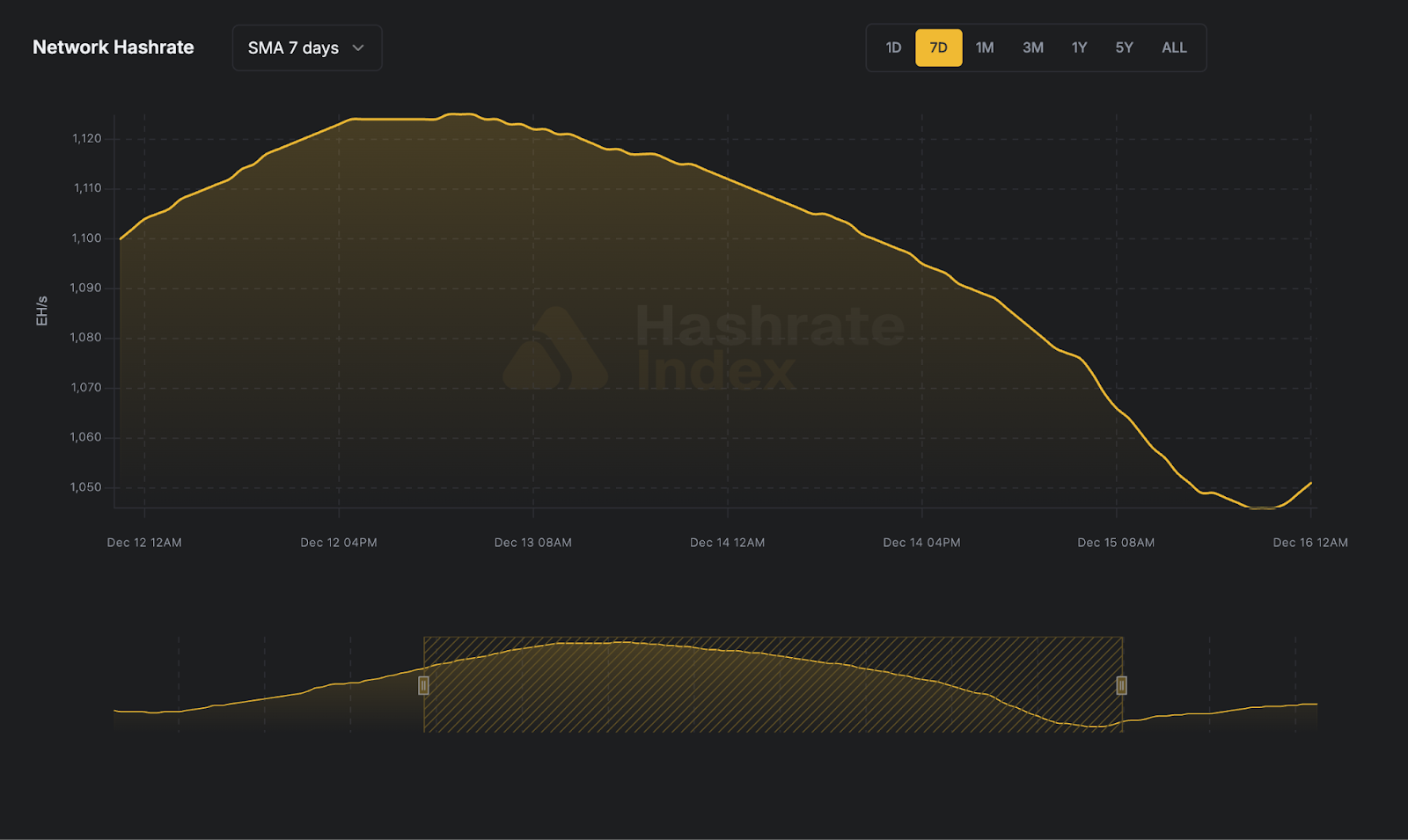
Hashprice Hedging Strategies for Bitcoin Miners
Using Forwards to Protect Against Financial Risk, Introduce Certainty into Business Planning, and Facilitate Access to Capital
Building a successful Bitcoin mining operation requires capital, physical infrastructure, computing hardware, low-cost energy, and an assortment of technical skills. Moreover, miners must navigate an ever expanding set of risks to their operations, including hashrate competition, crypto-prices, rising energy costs, access to capital and government scrutiny – just to name a few.
In traditional commodity markets, producers have long had access to a suite of financial products – specific to the commodity they produce – that protect against financial risk, introduce certainty into business planning, and facilitate access to capital. Farmers use forward contracts to lock-in prices for corn, wheat, and rice crops, among others. Oil and gas producers use futures contracts, and electricity providers use power purchase agreements. The list goes on.
However, for digital commodity markets, like Bitcoin mining, these products are only in their infancy.
Bitcoin miners produce hashrate. And what they are paid for that hashrate – what Luxor coined hashprice in 2019 – is a function not only of Bitcoin price, but also the block subsidy, transaction fees, and network difficulty.
Until very recently, miners only had access to Bitcoin futures and a small patchwork of physically-settled, short term-duration hashrate forward options. These limited hashrate hedging options left many miners exposed to significant hashprice risk, making it difficult to build defensible businesses in a highly cyclical industry.
In this commentary, we aim to help Bitcoin miners integrate Luxor’s Bitcoin Hashprice Non-Deliverable Forward into effective hedging strategies. These common strategies are used by producers across other commodity markets to protect against financial risk, introduce certainty into business planning, and facilitate access to capital.
What is Hedging?
The word hedge is synonymous with protection. When people hedge, they are protecting themselves against the possibility of an adverse outcome. It can be considered insurance for certain business risk exposures.
In financial and commodity markets, hedging generally involves the use of instruments called derivatives that can be used strategically to offset adverse outcomes. The most common derivatives used to hedge are forwards, futures, and options. However, there are many others as well. Each instrument used for hedging comes with pros and cons and may be leveraged for different use cases.
Protection from adverse outcomes, in exchange for upside, introduces a degree of certainty which market participants can incorporate into business planning. It allows a company to make capital investment, operating budget, and financing decisions with a higher degree of predictability. Protection from downside risks and higher cash flow certainty, in turn, facilitate access to capital.
What is a Forward?
Forward contracts (or forwards for short) are the simplest and oldest form of financial derivative. Evidence of their use dates back thousands of years, to the ancient civilizations of Mesopotamia, where clay tablets were used to record delivery dates for local produce.
A forward contract is made between two parties. It typically has one of two outcomes: physical delivery or cash settlement. In a physically delivered contract, one party agrees to buy a commodity on a future date, at a fixed price. The other party agrees to deliver that commodity or asset on the future date, at that fixed price. In a non-deliverable, cash-settled forward contract (NDF), the difference between the fixed price of the contract and the settlement value of the underlying commodity at the expiration of the contract is paid in cash from one party to the other.
In the context of forwards, a hedge is a transaction taking a position in the forward market opposite one’s position in the spot (i.e., current) market where a producer conducts business. Taking the opposite position allows gains or losses in one market to be offset by changes in the other market, establishing a price for a spot transaction in the future. As such, forward hedging is “locking-in” a price.
Luxor’s Bitcoin Hashprice NDF
Luxor’s Hashprice NDF brings together buyers and sellers of hashrate for standardized and customizable, non-deliverable hashprice forwards. After completing the appropriate onboarding documentation, the buyer and seller of a Luxor NDF contract simply agree to the following:
- Unit Hashprice – USD (e.g., $65.00 per PH/s/Day), or BTC (e.g., 0.00362 BTC per PH/s/Day).
- Daily Hashrate – Minimum 1 PH (e.g., 30 PH/s).
- Duration – 1-Month, 2-Month, 3-Month, and Customizable (e.g., 90 days).
Luxor facilitates the contract by matching counterparties, promoting price discovery, managing counterparty risk, providing Luxor Position Manager for daily profit and loss calculation, and acting as the settlement agent, as the contract is settled to Luxor’s Bitcoin Hashprice Index.
At contract expiration, the difference between the unit hashprice and the final settlement rate is settled in cash, stablecoin or Bitcoin. If the final settlement rate is higher than the unit hashprice, the seller pays the difference to the buyer. If the final settlement rate is lower than the unit hashprice, the buyer pays the difference to the seller.
The settlement rate is the average hashprice through the duration of the contract to account for the fact hashrate is a continuously delivered commodity (like electricity). This stands in contrast to a discreetly delivered commodity (like corn or oil), which would instead settle against the final market value of the commodity at the end of the contract.
Forward Hashprice Hedging Strategies for Bitcoin Miners
There are two common categories of forward price hedging strategies employed by commodity producers – a short hedge and a long hedge. Below we examine examples of both categories for a hypothetical Bitcoin mining operation using Luxor’s Bitcoin Hashprice NDF at $60.00 per PH/s/Day.
Strategy #1: A Short Hedge
First let's consider an example where the Bitcoin miner has 50 PH/s of daily hashrate and wants to hedge their entire exposure to hashprice for the next 30 days. That is, they want to “lock-in” a price to sell all their hashrate.
The miner continues normal mining operating activities and sells 1,500 NDF contracts (50 PH/s x 30 days) at $60.00 per PH/s/day unit hashprice. Assuming the miner is hashing, the NDF in this example will completely hedge (i.e., lock-in) total revenue of $90,000 (1,500 contracts x $60.00) or $83.33 per MWh ($90,000 / (1.5 MW x 24 hours x 30 days). With $81,000 in total electricity costs over the next 30 days (1.5 MW x $75.00 x 24 hours x 30 days), the miner has a hedged profit of $9,000 total or $8.33 per MWh.
To see how the NDF hedges the Bitcoin miner’s profit, let’s look at two potential scenarios at the end of the 30 day period. First, where the settlement rate is $45.00 per PH/s/Day at expiration. Second, where the settlement rate is $75.00 per PH/s/Day. Please note, we are using a extreme scenarios for illustration purposes.
In both scenarios the miner receives an amount equal to selling 50 PH/s for 30 days at $60.00 per PH/s/ day (i.e., $90,000) from unhedged mining revenue and the gain/loss of the NDF contract. Using Luxor’s Hashprice NDF, the miner is able to achieve hedged profit of $9,000 total or $8.33 per MWh despite significant variability across scenarios.
Now let's consider a more common short hedge strategy.
Suppose the Bitcoin miner wants to hedge enough hashrate to cover operating expenses for 30 days. At a $60 hashprice, the miner’s operating expense ratio (“OER”) is 90% (operating costs / revenue = $81,000 / $90,000). Please note that 90% is a historically high OER due to current mining economics. Higher hashprice and lower energy costs could lead to lower OERs.
To cover operating costs, the miner hedges 90% of their hashrate with Luxor’s Hashprice NDF. The miner continues normal mining operating activities and sells 1,350 contracts (90% OER x 50 PH/s x 30 days) at $60.00 per PH/s/Day unit hashprice.
Again, we evaluate two settlement scenarios. First, where the settlement rate is $45.00 per PH/s/Day at expiration. Second, where the settlement rate is $75.00 per PH/s/Day.
In both scenarios, the miner would receive at a minimum, an amount equal to selling 45 PH/s for 30 days at $60.00 per PH/s/ day (i.e., $81,000) from unhedged mining revenue and the gain/loss of the NDF contract. Using the NDF, the miner is able to cover operating expenses by guaranteeing the revenue they receive for their hashrate. This strategy can also be modified to cover capital expenditures and/or financing obligations.
Strategy #2: A Long Hedge
Now let’s consider a company that is hosting 50 PH/s daily hashrate of Bitcoin miners and commits to making their hosted miners whole when uptime is lower than agreed upon. In this situation, a hosting provider has a short spot hashprice position (i.e., their costs rise and profits fall as hashprice goes up) which can be hedged by buying Luxor’s Bitcoin Hashprice NDFs. That is, they want to “lock-in” a price to buy hashrate since they are curtailing mining activity.
First, let's consider the hosting company when operating at fully committed uptime.
The hosting company collects electricity and hosting charges from the Bitcoin miner to cover electricity costs, operating expenses, and profit margin. Full uptime ensures mining payout obligations are covered by mining revenue, and profit of $4,000 or $3.70 per MWh is guaranteed assuming no defaults.
Now let's consider the hosting company when operating at no uptime to take advantage of a curtailment program.
In both scenarios, with the settlement rate at $45 and $75 per PH/s/Day, the hosting company is paying an amount equal to buying 50 PH/s for 30 days at $60 per PH/s/Day from mining payouts and the gain/loss on the NDF contract. Using Luxor’s Hashprice NDF, the hosting company is able to take advantage of a curtailment program, cover their hashrate short position, and achieve hedged profit of $10,000 or $9.26 per MWh despite significant variability across scenarios.
Additional Considerations and Risks
There are also additional considerations and risks to be aware of when developing a hedging strategy.
One of these is basis risk. In the examples presented, we assumed identical pricing in the unhedged spot and forward market. That is, declining mining revenue due to drops in hashprice were exactly offset by gains in the NDF contract or vice versa.
In real life this is usually not the case. In particular, miners are typically paid out in Bitcoin and convert to U.S. dollars on a periodic basis. This can cause a deviation between a miner's US dollar revenue and NDF contract gain or loss, where movements in the spot market are not exactly counterbalanced by the NDF.
However, Luxor’s Bitcoin Hashprice NDF is a major improvement over products like Bitcoin futures in terms of basis risk. Bitcoin futures leave miners completely exposed to fluctuations in network difficulty and transaction fees.
Another consideration is uptime risk. When designing a hedging strategy, a miner should consider their expected hashrate based on estimated uptime. If a miner hedges based on 100% uptime, and does not achieve 100% uptime, there will be an imbalance between a miner's hedge and unhedged revenue.
Disclaimer
This content is for informational purposes only, you should not construe any such information or other material as legal, investment, financial, or other advice. Nothing contained in our content constitutes a solicitation, recommendation, endorsement, or offer by Luxor or any of Luxor’s employees to buy or sell any derivatives or other financial instruments in this or in any other jurisdiction in which such solicitation or offer would be unlawful under the derivatives laws of such jurisdiction.
There are risks associated with trading derivatives. Trading in derivatives involves risk of loss, loss of principal is possible.
Hashrate Index Newsletter
Join the newsletter to receive the latest updates in your inbox.







